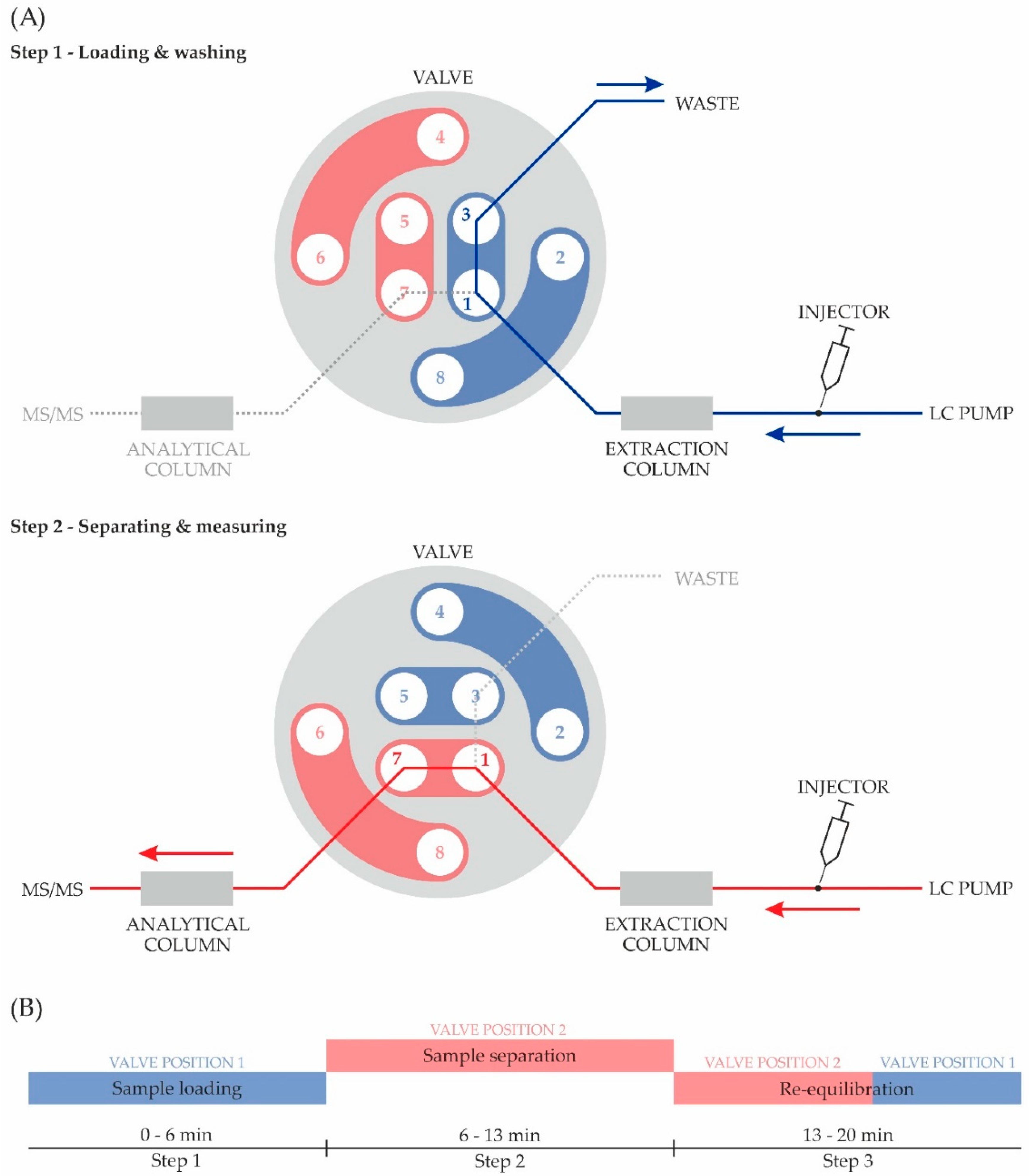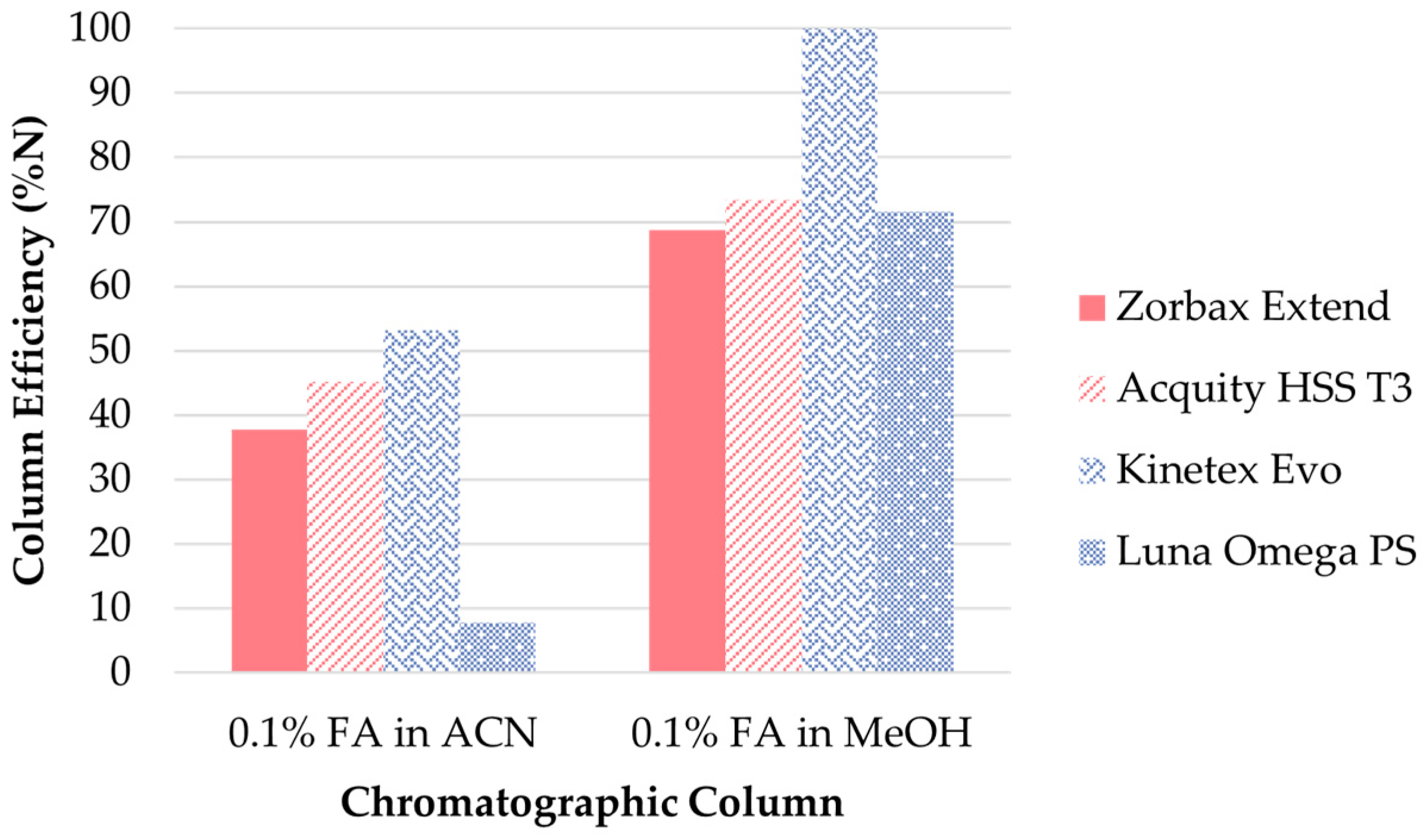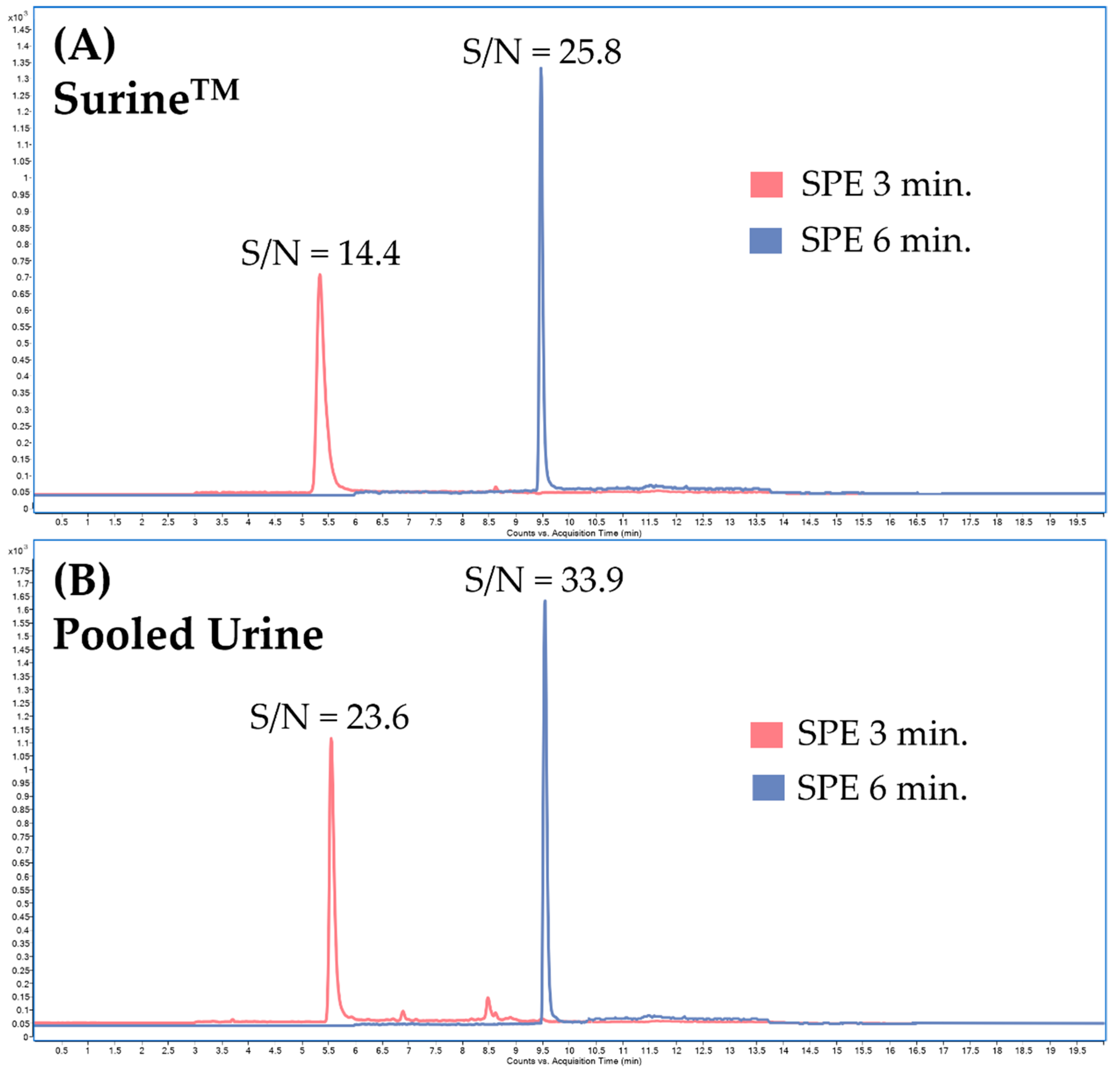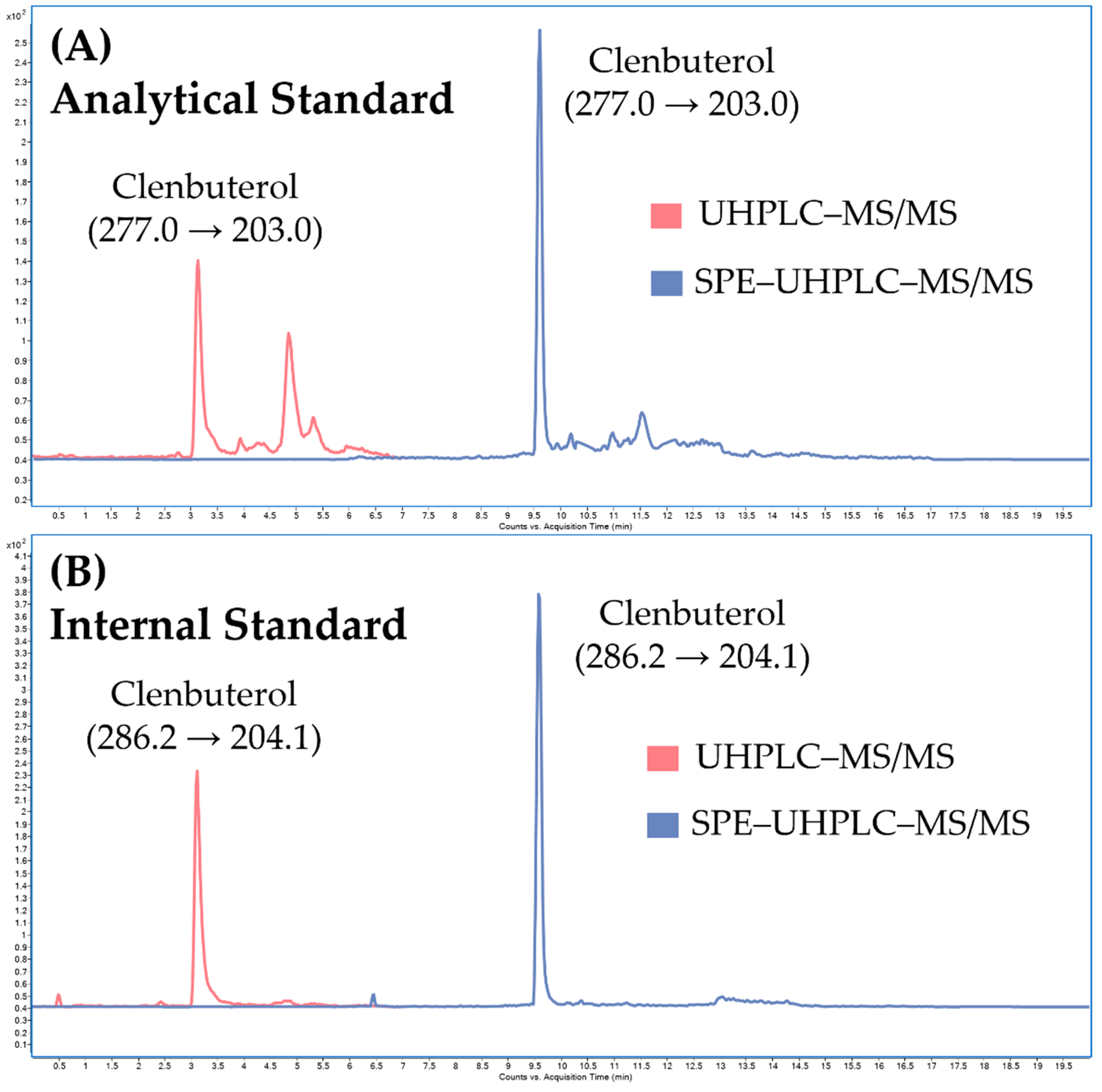Simple and Sensitive Analysis of Clenbuterol in Urine Matrices by UHPLC-MS/MS Method with Online-SPE Sample Preparation
Abstract
1. Introduction
2. Materials and Methods
2.1. Chemicals and Reagents
2.2. Online Solid Phase Extraction (Online-SPE)
2.3. LC–MS Conditions
2.4. Procedures for Stock Solutions, Standards and Samples
2.5. Method Validation
2.6. WADA Criteria for Method Application
3. Results and Discussion
3.1. Method Optimization
3.2. Method Validation
3.3. Method Application
4. Conclusions
Supplementary Materials
Author Contributions
Funding
Institutional Review Board Statement
Informed Consent Statement
Data Availability Statement
Acknowledgments
Conflicts of Interest
References
- Al-Majed, A.A.; Khalil, N.Y.; Khbrani, I.; Abdel-Aziz, H.A. Clenbuterol Hydrochloride. Profiles Drug Subst. Excip. Relat. Methodol. 2017, 42, 91–123. [Google Scholar] [PubMed]
- Parr, M.K.; Opferman, G.; Schanzer, W. Analytical methods for the detection of clenbuterol. Bioanalysis 2009, 1, 437–450. [Google Scholar] [CrossRef] [PubMed]
- Jessen, S.; Solheim, S.A.; Jacobson, G.A.; Eibye, K.; Bangsbo, J.; Nordsborg, N.B.; Hostrup, M. Beta2-adrenergic agonist clenbuterol increases energy expenditure and fat oxidation, and induces mTOR phosphorylation in skeletal muscle of young healthy men. Drug Test. Anal. 2020, 12, 610–618. [Google Scholar] [CrossRef]
- Parr, M.K.; Koehler, K.; Geyer, H.; Guddat, S.; Schanzer, W. Clenbuterol marketed as dietary supplement. Biomed. Chromatogr. 2008, 22, 298–300. [Google Scholar] [CrossRef] [PubMed]
- World Anti-Doping Agency. 2022 Prohibited List; World Anti-Doping Agency: Montreal, QC, Canada. Available online: https://www.wada-ama.org/sites/default/files/resources/files/2022list_final_en.pdf (accessed on 25 August 2022).
- World Anti-Doping Agency. Anti-Doping Testing Figures Report; World Anti-Doping Agency: Montreal, QC, Canada. Available online: https://www.wada-ama.org/en/resources/anti-doping-stats/anti-doping-testing-figures-report (accessed on 25 August 2022).
- World Anti-Doping Agency. 2021 International Standard for Laboratories; World Anti-Doping Agency: Montreal, QC, Canada. Available online: https://www.wada-ama.org/sites/default/files/resources/files/isl_2021.pdf (accessed on 25 August 2022).
- Yang, Z.; Wu, M.; He, G.; Dong, Y.; Ouyang, G.; Wu, Y.; Lu, J.; Yang, S.; Xu, Y.; Wang, X. An Improved LC–MS–MS Method for the Determination of Clenbuterol in Human Urine. LCGC Eur. 2012, 25, 612–617. [Google Scholar]
- Velasco-Bejarano, B.; Bautista, J.; Noguez, M.O.; Camacho, E.; Rodriguez, M.E.; Rodriguez, L. Resolution of R-(−) and S-(+)- enantiomers of clenbuterol in pharmaceutical preparations and black-market products using liquid chromatography-tandem mass spectrometry. Drug Test. Anal. 2017, 9, 1738–1743. [Google Scholar] [CrossRef] [PubMed]
- Prajapati, K.J.; Kothari, C. Development and Validation of a Stability Indicating LC-MS/MS Method for the Determination of Clenbuterol HCl. Drug Res. 2020, 70, 552–562. [Google Scholar] [CrossRef]
- Jia, J.Y.; Zhang, L.N.; Lu, Y.L.; Zhang, M.Q.; Liu, G.Y.; Liu, Y.M.; Lu, C.; Li, S.J.; Lu, Y.; Zhang, R.W.; et al. Hair analysis, a reliable and non-invasive method to evaluate the contamination by clenbuterol. Ecotoxicol. Environ. Saf. 2013, 93, 186–190. [Google Scholar] [CrossRef]
- Li, L.; Zhang, J.; Tang, C.; Zhao, Q. Accumulation of clenbuterol residues in the hair of Chinese Simmental beef cattle during and after treatment. J. Anal. Toxicol. 2014, 38, 52–56. [Google Scholar] [CrossRef]
- Krumbholz, A.; Anielski, P.; Gfrerer, L.; Graw, M.; Geyer, H.; Schanzer, W.; Dvorak, J.; Thieme, D. Statistical significance of hair analysis of clenbuterol to discriminate therapeutic use from contamination. Drug Test. Anal. 2014, 6, 1108–1116. [Google Scholar] [CrossRef]
- Duvivier, W.F.; van Beek, T.A.; Meijer, T.; Peeters, R.J.; Groot, M.J.; Sterk, S.S.; Nielen, M.W. Ultratrace LC-MS/MS analysis of segmented calf hair for retrospective assessment of time of clenbuterol administration in Agriforensics. J. Agric. Food Chem. 2015, 63, 493–499. [Google Scholar] [CrossRef] [PubMed]
- Montes Nino, A.M.; Granja, R.; Reche, K.; Giannotti, F.M.; de Souza, J.; Ferrari, S.; Dos Santos, A.D.; Wanschel, A.; Salerno, A.G. Laboratory validation of an LC-MS/MS method for the detection of ractopamine, clenbuterol and salbutamol in bovine and swine muscle at sub-μg kg-1 regulatory limits. Food Addit. Contam. Part A Chem. Anal. Control Expo. Risk Assess. 2017, 34, 785–792. [Google Scholar] [PubMed]
- Yikilmaz, Y.; Kuzukiran, O.; Erdogan, E.; Sen, F.; Kirmizibayrak, O.; Filazi, A. The determination of β-agonist residues in bovine tissues using liquid chromatography-tandem mass spectrometry. Biomed. Chromatogr. 2020, 34, e4926. [Google Scholar] [CrossRef] [PubMed]
- Solheim, S.A.; Jessen, S.; Morkeberg, J.; Thevis, M.; Dehnes, Y.; Eibye, K.; Hostrup, M.; Nordsborg, N.B. Single-dose administration of clenbuterol is detectable in dried blood spots. Drug Test. Anal. 2020, 12, 1366–1372. [Google Scholar] [CrossRef] [PubMed]
- Thevis, M.; Opfermann, G.; Schanzer, W. Liquid chromatography/electrospray ionization tandem mass spectrometric screening and confirmation methods for beta2-agonists in human or equine urine. J. Mass Spectrom. 2003, 38, 1197–1206. [Google Scholar] [CrossRef]
- Guddat, S.; Fußholler, G.; Geyer, H.; Thomas, A.; Braun, H.; Haenelt, N.; Schwenke, A.; Klose, C.; Thevis, M.; Schanzer, W. Clenbuterol—Regional food contamination a possible source for inadvertent doping in sports. Drug Test. Anal. 2012, 4, 534–538. [Google Scholar] [CrossRef]
- Nicoli, R.; Petrou, M.; Badoud, F.; Dvorak, J.; Saugy, M.; Baume, N. Quantification of clenbuterol at trace level in human urine by ultra-high pressure liquid chromatography-tandem mass spectrometry. J. Chromatogr. A 2013, 1292, 142–150. [Google Scholar] [CrossRef]
- He, G.; Sheng, L.; Zhang, J.; Wu, Y.; Zhao, X.; Xu, Y.; Lu, J. Enantiomeric analysis of clenbuterol in Chinese people by LC-MS/MS to distinguish doping abuse from meat contamination. Bioanalysis 2020, 12, 783–790. [Google Scholar] [CrossRef]
- Melwanki, M.B.; Huang, S.D.; Fuh, M.R. Three-phase solvent bar microextraction and determination of trace amounts of clenbuterol in human urine by liquid chromatography and electrospray tandem mass spectrometry. Talanta 2007, 72, 373–377. [Google Scholar] [CrossRef]
- Musenga, A.; Cowan, D.A. Use of ultra-high pressure liquid chromatography coupled to high resolution mass spectrometry for fast screening in high throughput doping control. J. Chromatogr. A 2013, 1288, 82–95. [Google Scholar] [CrossRef]
- Thevis, M.; Thomas, A.; Beuck, S.; Butch, A.; Dvorak, J.; Schanzer, W. Does the analysis of the enantiomeric composition of clenbuterol in human urine enable the differentiation of illicit clenbuterol administration from food contamination in sports drug testing? Rapid Commun. Mass Spectrom. 2013, 27, 507–512. [Google Scholar] [CrossRef] [PubMed]
- Goschl, L.; Gmeiner, G.; Enev, V.; Kratena, N.; Gartner, P.; Forsdahl, G. Development and validation of a simple online-SPE method coupled to high-resolution mass spectrometry for the analysis of stanozolol-N-glucuronides in urine samples. Drug Test. Anal. 2020, 12, 1031–1040. [Google Scholar] [CrossRef] [PubMed]
- ICH. ICH Harmonised Tripartite Guideline: Validation of Analytical Procedures: Text and Methodology, 4th ed.; European Medicines Agency: Amsterdam, The Netherlands, 2005. Available online: https://www.ich.org/page/quality-guidelines (accessed on 8 September 2022).
- Stefanik, O.; Horniakova, A.; Cizmarova, I.; Matuskova, M.; Mikusova, V.; Mikus, P.; Piestansky, J. Enhanced Sample Throughput Capillary Zone Electrophoresis with UV Detection in Hydrodynamically Closed System for Determination of Ibuprofen. Separations 2022, 9, 118. [Google Scholar] [CrossRef]
- Galba, J.; Piešťanský, J.; Kováč, A.; Olešová, D.; Cehlár, O.; Kertys, M.; Kozlík, P.; Chaľová, P.; Tirčová, B.; Slíž, K.; et al. Fast and Sensitive Screening of Oxandrolone and Its Major Metabolite 17-Epi-Oxandrolone in Human Urine by UHPLC—MS/MS with On-Line SPE Sample Pretreatment. Molecules 2021, 26, 480. [Google Scholar] [CrossRef] [PubMed]
- World Anti-Doping Agency. Minimum Criteria for Chromatographic-Mass Spectrometric Confirmation of the Identity of Analytes for Doping Control Purposes: TD2021IDCR; World Anti-Doping Agency: Montreal, QC, Canada, 2020; Available online: https://www.wada-ama.org/sites/default/files/resources/files/td2021idcr_final_eng_0.pdf (accessed on 19 September 2022).







| Compound | MRM Transition | Fragmentor Voltage [V] | Collision Energy [V] |
|---|---|---|---|
| clenbuterol | 277.0 → 203.0 (qualifier) | 90 | 10 |
| clenbuterol | 277.0 → 132.1 (identifier) | 90 | 10 |
| clenbutetol-d9 (IS) | 286.2 → 204.1 (qualifier) | 90 | 10 |
| clenbutetol-d9 (IS) | 286.2 → 133.1 (identifier) | 90 | 10 |
| Parameter | Clenbuterol |
|---|---|
| Linear range [ng/mL] | 0.1 to 50 |
| Slope (a) | 0.9999 |
| SDa (n = 18) | 0.0027 |
| Intercept (b) | 0.0013 |
| SDb (n = 18) | 0.0562 |
| r2 | 0.9999 |
| tR [min] (n = 18) | 9.483 |
| LOD [ng/mL] | 0.0125 |
| LOQ [ng/mL] | 0.1 |
| QC Sample | Intraday, n = 3 | Interday, n = 9 | ||||
|---|---|---|---|---|---|---|
| Nominal [ng/mL] | Found [ng/mL] | RSD [%] | RE [%] | Found [ng/mL] | RSD [%] | RE [%] |
| 0.5 | 0.45 | 2.41 | −10.5 | 0.47 | 4.96 | −5.5 |
| 2.5 | 2.35 | 1.40 | −5.9 | 2.44 | 8.11 | −2.6 |
| 25 | 23.64 | 1.70 | −5.4 | 26.38 | 7.70 | −5.5 |
| QC Sample | Intraday, n = 3 | Interday, n = 9 | ||||
|---|---|---|---|---|---|---|
| Nominal [ng/mL] | Found [ng/mL] | RSD [%] | RE [%] | Found [ng/mL] | RSD [%] | RE [%] |
| 0.5 | 0.47 | 4.86 | −5.1 | 0.49 | 4.80 | −1.6 |
| 2.5 | 2.47 | 2.96 | −1.3 | 2.46 | 8.99 | −1.5 |
| 25 | 23.77 | 1.26 | −4.9 | 26.72 | 8.17 | −6.9 |
Publisher’s Note: MDPI stays neutral with regard to jurisdictional claims in published maps and institutional affiliations. |
© 2022 by the authors. Licensee MDPI, Basel, Switzerland. This article is an open access article distributed under the terms and conditions of the Creative Commons Attribution (CC BY) license (https://creativecommons.org/licenses/by/4.0/).
Share and Cite
Slíž, K.; Olešová, D.; Piešťanský, J.; Mikuš, P. Simple and Sensitive Analysis of Clenbuterol in Urine Matrices by UHPLC-MS/MS Method with Online-SPE Sample Preparation. Separations 2022, 9, 440. https://doi.org/10.3390/separations9120440
Slíž K, Olešová D, Piešťanský J, Mikuš P. Simple and Sensitive Analysis of Clenbuterol in Urine Matrices by UHPLC-MS/MS Method with Online-SPE Sample Preparation. Separations. 2022; 9(12):440. https://doi.org/10.3390/separations9120440
Chicago/Turabian StyleSlíž, Kristián, Dominika Olešová, Juraj Piešťanský, and Peter Mikuš. 2022. "Simple and Sensitive Analysis of Clenbuterol in Urine Matrices by UHPLC-MS/MS Method with Online-SPE Sample Preparation" Separations 9, no. 12: 440. https://doi.org/10.3390/separations9120440
APA StyleSlíž, K., Olešová, D., Piešťanský, J., & Mikuš, P. (2022). Simple and Sensitive Analysis of Clenbuterol in Urine Matrices by UHPLC-MS/MS Method with Online-SPE Sample Preparation. Separations, 9(12), 440. https://doi.org/10.3390/separations9120440






